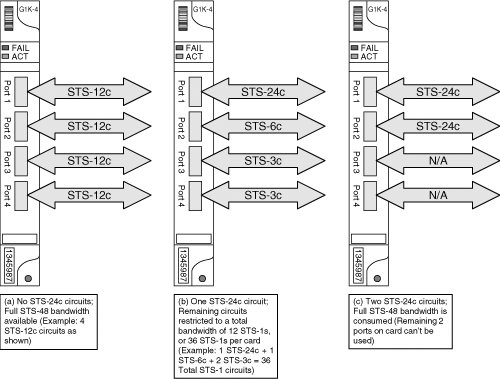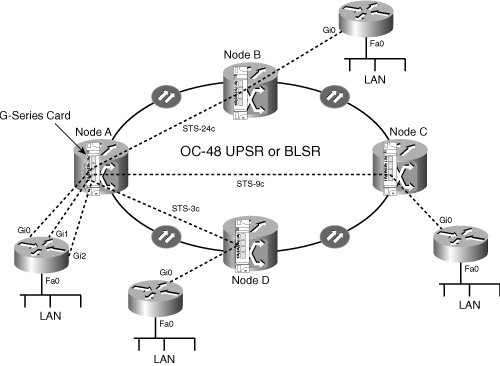ONS 15454 G-Series Interface Cards
| Cisco ONS 15454 G-Series (called G1K-4) Ethernet interface cards enable the provisioning of up to four point-to-point Layer 1mapped Ethernet services, which are also known as Ethernet private line (EPL) services. Each of the card's four ports can be independently equipped with modular Gigabit interface converters (GBICs), as needed, for service requirements. "Private line" is good terminology for this type of service because these connections are provisioned and act much like traditional private line services, such as a DS3 provisioned over a SONET network. The only major differences are that the Ethernet frames are transported natively instead of being packaged into a DS1 or DS3 frame, and the bandwidth of the link is variable within certain STS-1 or STS-Nc circuit sizes (where N can be 1, 3, 6, 9, 12, 24, or 48). Recall that an STS-24c circuit is required to provide full line-rate GigE connectivity between the two circuit endpoints and that the maximum bandwidth that can be used across the four ports of the G-Series cards is equal to 48 STS-1s. Figure 7-2 shows three examples of possible circuit terminations on the G-Series card. Figure 7-2. G-Series Ethernet Interface Card Circuit Termination Examples In Figure 7-2(a), each of the four ports is terminating a subrate (STS-12c or lower) circuit. For this type of configuration, there is no restriction on circuit terminations. In Figure 7-2(b), a single line-rate (STS-24c) circuit is terminated on port 1, and the other circuits terminated on the card are subrate circuits. In this case, a hardware restriction limits the total bandwidth provisioned across the combination of the other three ports to a maximum of 12 STS-1s. One possibility is shown in the example: An STS-6c circuit and two STS-3c circuits are used in combination with the single STS-24c circuit. Finally, Figure 7-2(c) shows an example of two line-rate STS-24c circuits terminated on ports 1 and 2 of the G-Series card. In this case, the remaining two ports (ports 3 and 4 in the example) cannot be used because the two line-rate circuits have reached the STS-48 total card bandwidth limit. ONS 15454 G-Series Card Example ApplicationFigure 7-3 shows an example application using the G-Series Ethernet interface card. In the four-node ONS 15454 OC-48 MSPP ring shown, the G-Series card at Node A is terminating a circuit from a corresponding G-Series card at each of the other three nodes. A line-rate circuit is carried between Node A and Node B, while subrate circuits are carried from Node A to Nodes C and D (an STS-9c and an STS-3c, respectively). This configuration is known as a "hub-and-spoke" application; Node A is the hub, with spoke circuits extending to each of the other sites. Figure 7-3. G-Series Card Example Application In this example, the router located at Node A is the hub router in the end user's data network. The interfaces of the router at the Node A location labeled Gi0 (GigE 0), Gi1, and Gi2 are equipped with GBICs or Small Form Factor Pluggables (SFPs) of the same wavelength as the GBICs installed in ports 1, 2, and 3 of the G-Series card installed in Node A. A fiber pair, either multimode (for 1000Base-SX GBICs/SFPs) or single-mode (for 1000Base-LX or 1000Base-ZX GBICs/SFPs) connects each G-Series card port to the corresponding router port. Similarly, the remote office routers located at Sites B, C, and D will have wavelength-matched interfaces connected to port 1 of their respective G-Series cards. In addition to the 1000Base-SX, 1000Base-LX, and 1000Base-ZX GBICs, the G-Series Ethernet cards support a variety of coarse wavelength-division multiplexing (CWDM) and dense wavelength-division multiplexing (DWDM) GBICs. The G-Series card supports any Layer 3 protocol that can be encapsulated and transported over GigE, such as Internet Protocol (IP) or Internet Packet Exchange (IPX). Important Features of the ONS 15454 G-Series CardThe G-Series cards provide several important features to ensure smooth operation of the end-user overlay Layer 2/Layer 3 network. Among these features are the support of standard flow control and frame buffering, link aggregation, and end-to-end Ethernet link integrity. Each of these features is discussed briefly in the sections that follow. Flow Control and Frame BufferingG-Series cards support flow control and frame buffering as defined in the Institute of Electrical and Electronic Engineers (IEEE) 802.3z. Each port on the G-Series card port has 512 KB of buffer memory to help prevent frame loss in case the attached transmitting source exceeds the throughput bandwidth provisioned to the port. If this buffer memory nears capacity (approximately 95 percent, by default), the G-Series port transmits a pause frame to the attached station instructing it to stop sending frames for a specified amount of time until the memory buffer is depleted and capable of storing additional information. The G-Series flow control is symmetrical, meaning that it can both send pause frames to the attached device and respond to pause frames received from the attached device. Flow control is set up on the G-Series card based on the provisioning of autonegotiation and flow control settings for the card port. The provisioning of these parameters is done separately in software releases 5.0 and later. If both the autonegotiation and flow control are enabled, the G-Series port attempts to negotiate symmetrical flow control with the attached equipment, and it might or might not be used. If autonegotiation is enabled but flow control is disabled, the G Series proposes no flow control. If autonegotiation is disabled, the G-Series card flow control is enabled or disabled based only on the card provisioning, regardless of the provisioning of the attached port. The G-Series card ports have provisionable thresholds, or watermarks, for pause/resume signaling to the attached port. These watermarks define the maximum data for the buffer to hold before the transmission of a pause frame, as well as the amount of data at which the card will signal to resume transmission to the attached device. The default value for the transmission of a pause frame is 485 KB; the default value for transmission of a signal to resume transmission is 25 KB. Link AggregationThe G-Series card supports point-to-point link aggregation between attached devices. This enables the bundling of multiple GigE links for greater bandwidth or higher levels of equipment redundancy to ensure high availability. G-Series cards support all types of link aggregation, including the IEEE 802.3ad implementation and the Cisco-proprietary Gigabit EtherChannel (GEC). The GEC protocol does not run on the G-Series cards, but it allows the SONET ring to be transparent to GEC-enabled devices routed through the network. STP running on these devices operates as though the multiple links were a single link, and does not block the redundant paths. The total throughput of the aggregated link is the sum of the bandwidth of the circuits provisioned. Any combination of circuit sizes can be used to form the parallel combination. These circuits can be distributed over G-Series card ports to provide varying levels of redundancy:
Ethernet Link IntegrityThe G-Series cards also support Ethernet link integrity, which helps to ensure correct operation of the Layer 2 and Layer 3 protocols running on the attached Ethernet devices, such as customer premises equipment (CPE). This feature operates by shutting down the transmit laser on the G-Series port at each circuit-termination point if any part of the Ethernet link experiences a failure. This allows the end devices to detect a loss of carrier and mark the link as out of service. If one of the endpoint ports is administratively disabled (through Cisco Transport Controller [CTC], for example) or has been set in loopback, it is considered to be in a failed condition for the purposes of the operation of link integrity, and the transmit laser at each end is disabled. |
EAN: 2147483647
Pages: 140